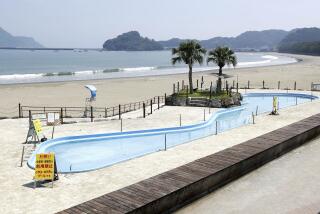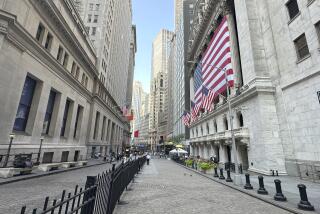Japan quake likely to affect business globally
With the scale of the disaster in Japan still being measured, concerns are growing that last week’s earthquake and tsunami could lead to a long-term disruption in the world’s supply of automobiles, consumer electronics and machine tools.
Japan is the world’s third-largest economy and a huge exporter of cars, electronic components and industrial equipment as well as steel, textiles and processed foods. In turn, it’s a voracious consumer of petroleum, imported agricultural products and luxury consumer goods.
Since the earthquake struck last Friday, many of the nation’s largest manufacturers, including automaker Toyota Motor Corp. and electronics maker Toshiba Corp., have been forced to slow or shut down production as they deal with supply chain interruptions, energy shortages and transportation problems.
And while many of those idled plants are expected to come back online soon, questions loom about the lasting effect on the Japanese economy as the country struggles to rebuild. The reconstruction costs could well surpass $100 billion, according to some estimates.
Already burdened with persistent deflation, shrinking foreign investment and massive borrowing, Japan’s economy now faces what could be far darker clouds as it struggles to take measure of the destruction in its northeastern coast. Almost certainly, Japan will be forced to borrow more money, which could drive up the value of the yen, making it harder to export products.
Japan “is starting from a lousy fiscal position,” said Marcus Noland, senior fellow at the Peterson Institute and an expert on Asian economics.
“If this can be contained, the economic implications may not be long term,” Noland said. He compared the situation to the 1995 quake in Kobe, Japan, which struck a far more industrialized zone but carried less of a risk of nationwide disruption because utilities were relatively unaffected. “If not, then it could have implications not only for Japan, but for the global economy.”
Energy
The pace of recovery may hinge on the country’s energy supply. Japan’s manufacturing is electricity-intensive, and the country gets about 30% of its power from nuclear plants, although it also relies on fossil fuels.
Because of the disaster, about a fifth of the nation’s nuclear plants are off-line. New data from Platts, an energy information company, on Monday indicates that 31% of Japan’s refining capacity has been reduced or shut down. Utilities are enforcing rolling blackouts to deal with the supply problem, at least temporarily.
Noland said that if there was a permanent reduction in national capacity, the economic effect could be severe. “It all comes down to the electrical grid,” he said.
Autos
Toyota, the world’s largest automaker and Japan’s biggest company, has halted all production in Japan, including its hybrid Prius vehicle, through Wednesday, representing 45% of its worldwide supply. Automakers Nissan, Mitsubishi, Mazda, Subaru and Suzuki have also temporarily shut down their plants to help conserve electricity.
Honda Motor Co., Japan’s fourth-largest company, has shuttered several of its plants, including one in Suzuka, where it produces many of its hybrid vehicles, a painful product to lose as worldwide gasoline prices soar and demand for fuel-efficient vehicles rises. Also, two Toyota plants in the disaster-struck Sendai region produce some of the automaker’s more fuel-efficient offerings, including the Yaris subcompact.
Nissan Motor Co. said it lost almost 2,300 vehicles awaiting shipment at an eastern port that were destroyed by the tsunami.
Shares in the Japanese auto sector traded down heavily Monday, with Toyota falling 8% and Nissan down nearly 10% in trading on the Tokyo Stock Exchange.
Although those production setbacks might seem like an opportunity for ambitious foreign competitors such as South Korea’s Hyundai, Germany’s Volkswagen and a resurgent Ford Motor Co., Rebecca Lindland of IHS Global Insight notes that most Japanese automakers today produce vehicles in the countries where they sell them. According to Honda, for example, 80% of the vehicles it sells in the U.S. are built here.
Moreover, Lindland said, disruptions at Japan’s automotive suppliers could hurt brands from all over the world. That’s because carmakers depend on complex global supply chains, and even Chevrolets built in Michigan use Japanese components.
“Nobody works in isolation these days,” Lindland said. “All it takes is one missing part. If you’re missing something as simple as the cup holder, you aren’t selling that car.”
Technology
Japan’s largest technology firms have shut down dozens of factories that produce an array of microchips and consumer electronics products, including computers, cameras and popular smart phones.
Officials at Toshiba, Canon Inc., Fujitsu Ltd., Panasonic Corp. and Sony Corp. confirmed many plant closures in several prefectures of the hard-hit Tokohu region, citing injuries to employees, damage to facilities and the need to conserve electrical power as requested by the Japanese government.
“It’s a very dire situation right now,” Fujitsu spokesman Scott Ikeda said.
Toshiba shares fell 17% on Monday on the Tokyo exchange, while Fujitsu slumped more than 6%.
Among the sectors most affected is the $18-billion market for so-called NAND chips — the small data-storage units that fit into smart phones and tablet computers and allow users to store video, music and photos. Japan, and specifically Toshiba, account for about 35% of the world’s production of NAND chips, according to research firm IHS iSuppli.
The chips can be found inside hot consumer devices such as the recent iPad 2 tablet, as well as Apple Inc.’s iPhone and Motorola Inc.’s Droid X smart phone.
“The major impact on Japan’s semiconductor production is not likely to be direct damage to production facilities, but disruption to the supply chain,” iSuppli analyst Dale Ford said in a note to investors Monday.
Agriculture
Japan’s disaster-struck northern region, though relatively undeveloped in terms of industrial production, is one of the nation’s leading areas for rice production, and Japan as a whole is one of the world’s largest importers of corn and wheat.
Speculation that demand for imported grains would rise in Japan drove up corn, wheat and soybean futures in the U.S.
California Department of Food and Agriculture Secretary Karen Ross said Japan was a key export market for farmers in the state, particularly for specialty crops such as blueberries, cherries and pomegranates. She warned a gathering of grape and fruit growers Monday that the state’s farmers probably would see a “disruptive” effect on their business.
There seemed to be a small silver lining in the disaster’s aftermath. Oil prices fell slightly over the weekend after a long run-up in the face of unrest in the Middle East.
But concerns grew that the disaster in Japan could drive up fuel prices in the long term, in turn cooling a boom in domestic farm exports.
Stock markets
Stocks fell sharply Monday in Japan, where the Nikkei index slumped 6.2%, compared with only moderate losses in most of the rest of the world.
The Dow Jones industrial average slid almost 150 points early on, but recovered late in the day to close down 51.24 points, or 0.4%, at 11,993.16. Stocks fell 0.9% in Britain, 1.3% in France and 1.7% in Germany. Stocks in Hong Kong rose 0.4%.
Among U.S. companies, luxury goods makers, insurers and utilities tied to the nuclear energy industry were among the losers.
Companies specializing in other forms of energy, such as coal to solar power, were big winners as investors bet that they could gain from a potential backlash against nuclear energy because of the unfolding disaster at the Fukushima reactor.
Insurance stocks fell as investors worried the industry could be on the hook for big payouts.
AIR Worldwide, a disaster research firm, estimated that initial insured property and casualty losses could reach as much as $35 billion. Other analysts put the number at nearly twice that level. Aflac Inc. and Genworth Financial Inc. each fell 3%.
“It will take some time before we have any inkling of how much this will cost,” said Sam Stovall, chief investment strategist at Standard & Poor’s Corp. “Right now investors are fearing the worst and acting accordingly.”
Times staff writers Andrea Chang, Walter Hamilton, P.J. Huffstutter, Hugo Martin and David Sarno contributed to this report.
More to Read
Inside the business of entertainment
The Wide Shot brings you news, analysis and insights on everything from streaming wars to production — and what it all means for the future.
You may occasionally receive promotional content from the Los Angeles Times.










